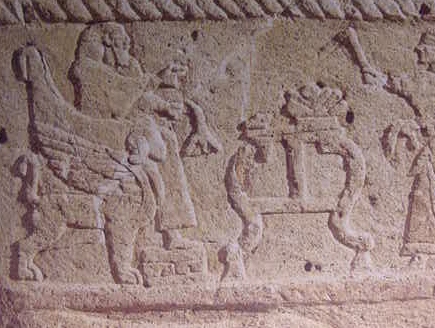Below, King Hiram of Byblos, on a Cherubim Throne -the bas relief is from his sarcophagus- The Cherubim have been identified as Winged Sphinxes (p. 127. Sabatino Moscati. The Phoenicians. Gruppo Editoriale Fabbri Bompiani, Sonzono, Etas S.p.A. Milan. March 1988).
Please note that Moscati dates the sarchopagus to the 13th-12th century BCE :
"The oldest and most famous Phoenician sarcophagus, that of King Ahiram (as its inscription states) belongs to the Syro-Palestinian area. The work dates back to the 13th-12th century BC, while there is some doubt as to whether the inscription is contemporary or later." (p. 293. Moscati. 1988. The Phoenicians.)
Below an ink sketch of King Hiram of Byblos (our word "Bible" is derived from Byblos, ancient Gebal) in Phoenicia, seated on a "Cherub throne" according to the late Professor William Foxwell Albright, who dates Hiram to the 10th century BCE and world of King Solomon. The king holds a Lotus in his hand. The scene is from his stone sarcophagus. In Egyptian tomb art, the righteous dead are frequently shown seated on a chair, holding a Lotus near their nose. For the Egyptians, the Sun-god was born each day and arose from a giant Lotus. By showing a Lotus in their hand, they expressed a conviction or hope that they too would be reborn from the giant Lotus each day and enjoy immortality. (for the ink sketch cf. p. 96. William Foxwell Albright. "What were the Cherubim ?" G. Ernest Wright & David Noel Freedman. Editors. The Biblical Archaeologist Reader. Chicago. Quadrangle Books, Incorporated. 1961)
Please scroll down for a photo of the sarcophagus and the Cherub throne.
